Maxillary and Mandibular Canines
1/27
There's no tags or description
Looks like no tags are added yet.
Name | Mastery | Learn | Test | Matching | Spaced |
|---|
No study sessions yet.
28 Terms
teeth numbers
6, 11, 22, 27
permanent tooth calcification
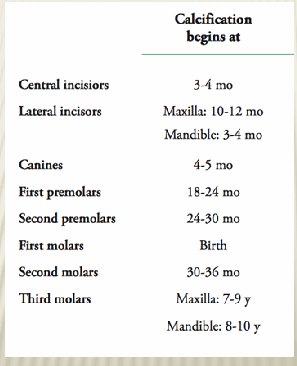
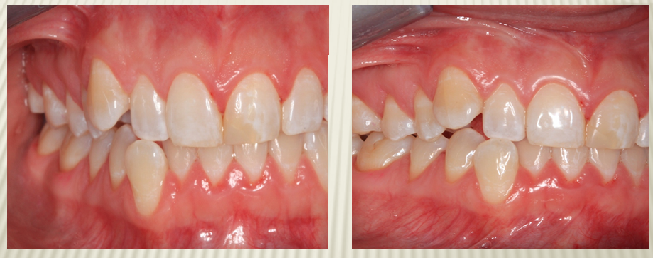
-flaring of canines
canine risks
-more prone to gingival recession
-most force during brushing concentrated on canines
-pocket reduction surgery can eliminate pockets, but can lead to gingival recession

facial view
-labial ridge more pronounced on maxillary
-shallow developmental depressions lie mesial and distal to the labial ridge
-distal cusp ridge (cusp slope)
-mesial cusp ride (cusp slope)
-cusp tip
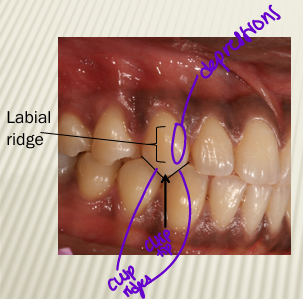
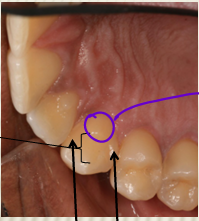
lingual view
-two fossas (mesiolingual and distolingual)
-lingual ridge
-cingulum (circle)
-^all of the above features more pronounced on maxillary canine than on mandibular canine
-two marginal ridges
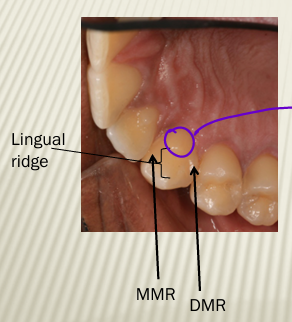
eruption of canines
-develop from four lobes: three facial and one lingual
-active eruption of teeth occurs after 2/3rds of the root is formed
-root not fully formed until 2-3 years after eruption
-no mamelons on newly erupted canines
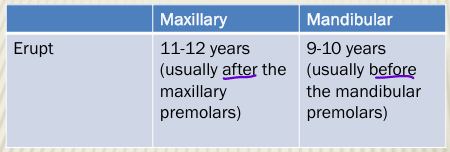
cingulum
-lingual lobe of an anterior tooth
-all anterior teeth have one cingulum
-maxillary canine has largest cingulum of all anterior teeth
-cingula may resemble cusps for canines (especially for maxillary canine)
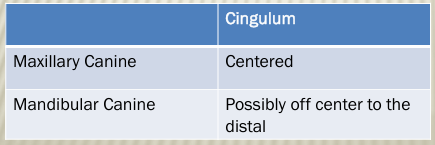
summary of cingulum location for anterior teeth

maxillary and mandibular canine dimensions
-faciolingual dimension is greater than the mesiodistal dimension
-incisogingival dimension greater than the mesiodistal dimension
-mesial cusp ridge shorter than the distal cusp ridge (more so on mandibular canines than on maxillary)
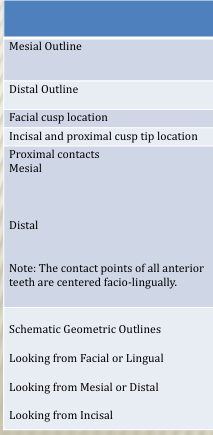
outline forms and contact areas- 6 and 11
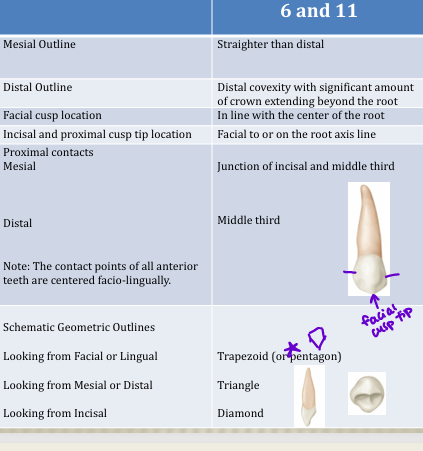
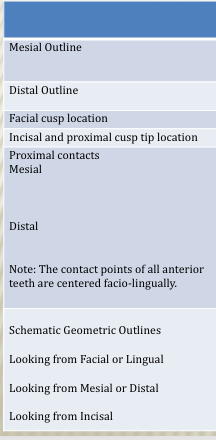
outline forms and contact areas- 22 and 27
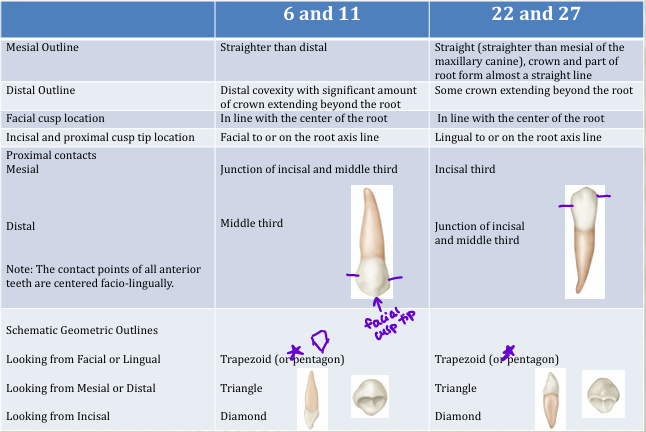
summary of anterior teeth contact areas
-mesial surface listed first, followed by distal

maxillary and mandibular canines are the least often
-extracted teeth; very strong
maxillary canines
-maxillary canines has a very prominent labial ridge (more so than mandibular canine)
-greatest FL dimension of any anterior tooth
-has longest root of all teeth
-longest tooth overall of all teeth (root + crown)
-root produces a bony labial ridge called the canine eminence
-arrow points to canine eminence
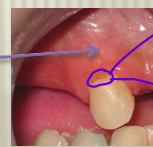
mandibular canines
-mandibular canine has longest crown of any tooth
-has smoother anatomy than that of maxillary canine in all respects making the tooth very resistant to decay (dental caries)
-usually does not have pits or grooves
heights of contour
-area of greatest amount of curvature on a tooth
-for all anterior teeth, facial and lingual heights of contour are on cervical third of crown
-on mesial and distal of a tooth, always at contact area

CEJ
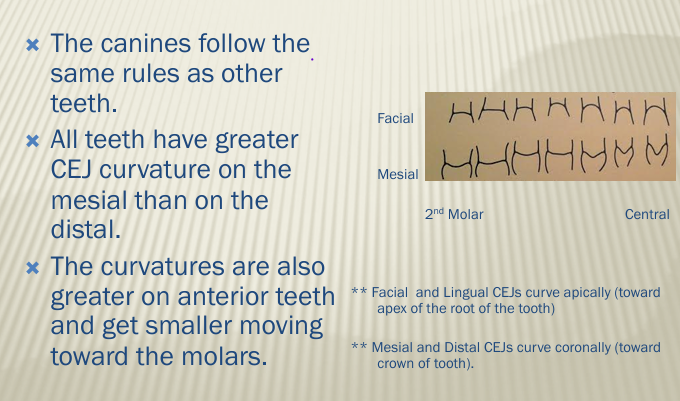
distinguishing between the maxillary and mandibular canine
-when viewed from facial, the mandibular canine has a much straighter mesial outline and is narrower MD
-when viewed from proximal and incisal, the cusp tip of mandibular canine displaced lingually or in line with the root whereas the maxillary canine it is facial to or in line with the root
-cingulum less pronounced and off center to the distal for the mandibular canine
root form- maxillary
-one root, one canal
-longest root of all teeth
root form- mandibular
-one root that may be bifurcated into facial and lingual parts near the apical 1/3
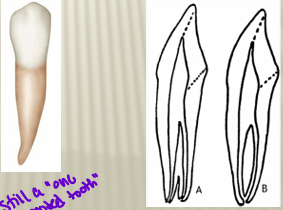
occlusion of the canines
-mandibular canine occludes with the maxillary lateral and maxillary canine in the intercuspal position (its counterpart and one tooth mesial)
-maxillary canine occludes with the mandibular canine and mandibular 1st premolar in the intercuspal position (its counterpart and one tooth distal)
-cusp tip of maxillary canine falls in the facial embrasure between the mandibular canine and 1st premolar in ideal Class I occlusion
-maxillary canine unique- an anterior tooth that occludes with both an anterior and a posterior tooth in the intercuspal position
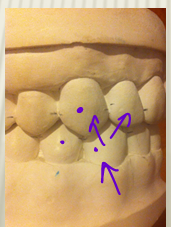
class I canine occlusion
-maxillary canine in embrasure between mandibular canine and first premolar
-most common occlusion: ~70% of the population
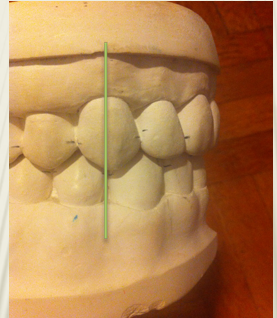
class II canine occlusion
-maxillary canine mesial to embrasure between the mandibular canine and 1st premolar
-less common occlusion: ~25% of the population
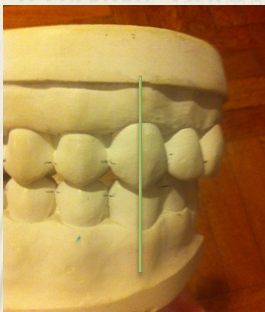
class III canine occlusion
-maxillary canine distal to embrasure between the mandibular canine and first premolar
-least common occlusion: less than 5% of the population
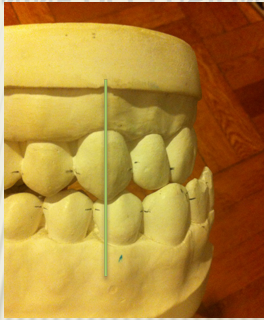
overbite
-vertical distance by which the maxillary incisors overlap the mandibular incisors
-aka vertical overlap
-normal overbite is when the maxillary incisal edges fall within the incisal 1/3 of the mandibular incisors
overjet
-horizontal distance between the lingual surfaces of the maxillary incisors and the labial surfaces of the mandibular incisors
-aka horizontal overlap
-normal overjet approximately 1-2mm
canine guidance
-canine or cuspid protected occlusion
-an occlusal relationship in which the canines produce a disclusion (separation) of all of the posterior teeth when the mandible moves to either side